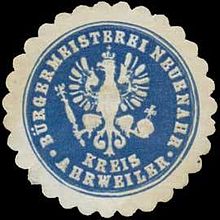Neuenahr mayor
The mayor's office in Neuenahr was a Prussian administrative district in the Ahrweiler district , which was part of the Koblenz administrative district in the Rhine Province . The mayor's office was established in 1875 from the mayor's office of Ahrweiler-Land as an independent rural mayor's office and existed until 1927. Five municipalities were subordinate to the administration of the Neuenahr mayor's office. In 1927 the mayor's office in Neuenahr was renamed to Amt Bad Neuenahr .
Municipalities and associated localities
Structure of the mayor's office in Neuenahr; Population numbers (Ew. 1885) according to the census of December 1, 1885:
| local community | associated towns and places of residence | Ew. 1885 | Remarks |
|---|---|---|---|
| Gimmies | Landskronerhof | 200 | today the district of Gimmigen |
| Heimersheim | Heppingen , Ehlingen , Apollinarisbrunnen , Heppingerbrunnen , Idsenmühle | 1,287 | today the districts of Heimersheim and Heppingen |
| Kirchdaun | 218 | today the Kirchdaun district | |
| Lohrsdorf | Green , Koehlerhof | 359 | today Lohrsdorf district |
| Neuenahr | Beul , Hemmessen , Wadenheim , Landmühle | 1,280 | today the district of Bad Neuenahr |
All communities existed until 1969 and have belonged to the city of Bad Neuenahr-Ahrweiler since June 7, 1969 .
history
Neuenahr mayor
After the later Rhine province was taken over by the Kingdom of Prussia (1815), the districts established in 1816 were divided into several mayor's offices , to which several municipalities were usually assigned.
The administrative district of the mayor's office of Neuenahr originally belonged to the mayor's office of Ahrweiler .
After the city ordinance for the Rhine Province came into effect on May 15, 1856, the city of Ahrweiler left the mayor's association on March 2, 1857 and formed its own urban administrative district. The rural communities of Gimmigen (then Gimmingen ), Heimersheim, Lohrsdorf, Kirchdaun and Wadenheim formed the new mayor's office "Ahrweiler-Land". It was administered in personal union by the mayor of the city of Ahrweiler, Josef Wilhelm Clotten.
In 1874, the community of Wadenheim suggested separating from Ahrweiler due to its development into a health resort. By order of January 26, 1875, the royal government, Department of the Interior, decided in Koblenz to abolish the personal union and to set up a special rural mayor's office with its seat in Wadenheim. A little later, the municipality of Wadenheim , which was formed from the three localities of Wadenheim , Beul and Hemmessen , was authorized by royal approval on June 9, 1875 to use the name "Municipality of Neuenahr".
Since then, the mayor's office has also been called "Neuenahr", and the mayor's seat was in the Wadenheim district.
In the administrative area of the mayor's office in Neuenahr lived a total of 4,278 inhabitants in 899 households in 1885; 2,125 of the residents were male and 2,153 female. Regarding religious affiliation, 4,081 were Catholic and 158 were Protestant; the total of 38 Jews lived in Heimersheim and Neuenahr.
Bad Neuenahr office
Since 1927 the community was allowed to use the name "Bad Neuenahr".
On the basis of the Prussian " Law on the Regulation of Various Points of Municipal Constitutional Law " of December 27, 1927, all rural mayor offices were renamed.
The Bad Neuenahr office that was created in this way also existed after 1946 in the newly formed state of Rhineland-Palatinate until the reorganization of the Bad Neuenahr community in 1968.
Bad Neuenahr commune
In the course of the Rhineland-Palatinate functional and territorial reform on October 1, 1968, all offices in the then administrative district of Koblenz were converted into association communities .
The provisional Verbandsgemeinde Bad Neuenahr had the same territorial status and the same municipality allocation as the Mayor's Office Ahrweiler-Land from 1857. On June 7, 1969, the Verbandsgemeinde Bad Neuenahr was finally dissolved, the associated municipalities merged into the newly formed town of Bad Neuenahr-Ahrweiler .
Individual evidence
- ↑ a b Community encyclopedia for the Kingdom of Prussia , Volume XII Province Rhineland, Publishing House of the Royal Statistical Bureau (Ed.), 1888, p. 36 ff ( digitalis.uni-koeln.de )
- ↑ a b Jakob Rausch: 150 years Ahrweiler district , 1966 home yearbook of the Ahrweiler district ( online edition )
- ↑ Heimatverein “Alt-Ahrweiler” e. V .: Mayor of the city of Ahrweiler ( Memento of the original from January 11, 2016 in the Internet Archive ) Info: The archive link was inserted automatically and has not yet been checked. Please check the original and archive link according to the instructions and then remove this notice.
- ↑ Jakob Rausch: The name Neuenahr in a historical exhibition , 1958 home yearbook of the Ahrweiler district ( online edition )
- ↑ Josef Ruland: Reflections on the history of Neuenahr on the occasion of 1000 years of Wadenheim , 1993 homeland yearbook of the Ahrweiler district ( online edition )
- ↑ Landschaftsverband Westfalen-Lippe, State Office for Archive Maintenance: Archive Maintenance in Westphalia and Lippe , page 4 (PDF; 959 kB)
- ↑ Heinz Korbach : Administrative reform in the Ahrweiler district , 1972 homeland yearbook of the Ahrweiler district ( online edition )
- ↑ Official municipality directory (= State Statistical Office of Rhineland-Palatinate [Hrsg.]: Statistical volumes . Volume 407 ). Bad Ems February 2016, p. 158 (PDF; 2.8 MB).

